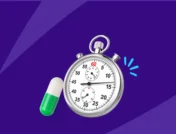Whether you regularly exercise or you’re just starting to add physical activity to your routine, it’s important to keep in mind any prescriptions you may be taking. Medications, such as Adderall, can change how you feel before, during, and after your workout. People with symptoms of ADHD may find that Adderall not only helps improve their focus and attention but also affects their exercise and physical activity.
Adderall (mixed amphetamine salts) is a stimulant medication that is commonly used to improve focus, attention span, and alertness in adults and children with attention deficit hyperactivity disorder (ADHD). It can also promote wakefulness in people diagnosed with a sleep disorder called narcolepsy. Adderall is available in immediate-release tablets and extended-release capsules (Adderall XR).
Common Adderall side effects
Adderall can cause side effects such as:
- Insomnia or trouble sleeping
- Dry mouth
- Headache
- Nausea
- Abdominal pain
- Decreased appetite
- Nervousness
Side effects are more common when first starting treatment with Adderall than they are with long-term use. You may also be at an increased risk of side effects if you’re taking high doses. However, your healthcare provider will adjust your dosage based on your response to treatment and any side effects you experience. Most side effects are mild and go away over time.
RELATED: Adderall vs. Adderall XR
Is it safe to exercise while taking Adderall?
Generally, yes—Adderall and exercise are safe, but it’s best to log that workout before taking your daily dose. Stimulant medications can increase heart rate and breathing rate, so it may be preferable to take Adderall after exercising instead of before. And, make sure to talk to your healthcare provider first, especially if you have underlying heart problems—whether you’re taking 10 mg, 30 mg, or another dosage.
“Any person on Adderall should consult with their provider to determine if it’s safe to exercise while using the medication, one that’s familiar with their history and activity level,” says Daphne Scott, MD, a sports medicine specialist at Hospital for Special Surgeries in Manhattan, New York.
RELATED: Is it safe to exercise while taking an Rx that increases heart rate?
What side effects can Adderall cause while working out?
Side effects can develop whether or not a person is working out while on Adderall. However, Adderall can cause certain side effects that can affect someone’s regular exercise routine, such as:
- Elevated blood pressure
- Increased heart rate
- Palpitations
- Dizziness
- Tremors
Someone with a past history of shortness of breath, chest pain, or dizziness while working out should be monitored with continued use of the drug. These side effects may be more frequent when engaging in cardio exercises, such as running or swimming for long distances. There may be an increased risk of these side effects when Adderall is combined with other stimulants (like caffeine from coffee or supplements), or when Adderall is abused or taken in a different way than prescribed (in multiple, high doses at once).
Call your healthcare provider immediately, or seek emergency attention, if you notice chest pain or trouble breathing while working out on Adderall.
Can Adderall be used as a workout aid?
Some researchers believe that stimulant medications, like Adderall, could improve workout performance. “Stimulants in general improve attention, concentration, and focus,” comments Steven Karceski, MD, an assistant professor of neurology at Weill Cornell Medicine. “There may be some logic in terms of [how Adderall] impacts quickness. Not just mental performance but also physical performance may be impacted.”
Recent years have seen an uptick in individuals using Adderall to enhance their physical performance or support their weight loss goals. While Adderall can inadvertently promote physical performance and weight loss, it’s crucial to note that no one should take Adderall without a prescription from a doctor.
Abusing or misusing Adderall can increase the risk of side effects, which may affect how the body recovers post workout and lead to negative health consequences. Currently, Adderall is not approved for use as a workout supplement or diet pill, and it is classified as a Schedule ll controlled substance that has a high risk of abuse and physical or psychological dependence.
Working out on Adderall purely to boost physical abilities and energy levels is illegal and dangerous. According to a 2016 study of people taking stimulants who were given a treadmill exercise test. Compared with nonusers, the use of stimulants was associated with a decreased peak heart rate and an increased risk of chronotropic incompetence, defined as the inability to increase the heart rate (HR) to match the body’s demand during exercise. In other words, taking ADHD medications during exercise may lead to reduced exercise tolerance, lower quality of life, and increased risk of cardiac events.
“If I encounter someone who may be looking to take the medication without a prescription,” Dr. Scott says, “I strongly discourage it given [the] potential harm in using a controlled substance without proper monitoring.”
How might Adderall interact with workout supplements?
Adderall, even when taken as prescribed, can be harmful when combined with other stimulants. Most pre-workout supplements contain some form of caffeine, a known central nervous system (CNS) stimulant. Taking more than one stimulant at a time can increase stress on the heart and lead to heart issues. In severe cases, combining stimulants can lead to a heart attack or stroke, especially in people with a history of heart problems or high blood pressure.
Talk to your healthcare provider or pharmacist before taking any vitamins or supplements. They can help you determine your risk for a drug-drug interaction and advise you on how to incorporate supplements into your routine, if needed. An open conversation with your medical team can help you maintain an active lifestyle in the safest way possible.
How to workout safely using Adderall
You should only take Adderall as prescribed under the supervision of a healthcare provider. When used as directed, you can work out safely while taking this medication. Just be sure to follow these steps:
- Take only your prescribed dose. Don’t double up or take extra Adderall to boost the effects of exercise.
- Stop exercising if you experience symptoms like increased heart rate, dizziness, and shortness of breath.
- If you have any health conditions, make sure your provider clears you to exercise first.
- Schedule your workouts first thing in the morning before you take your daily dose.
- Ask your healthcare provider if you should adjust the timing of subsequent doses during the day. It may be safer to take it after a workout instead of before.
When in doubt, discuss your exercise plans with your prescribing physician or pharmacist for advice.











